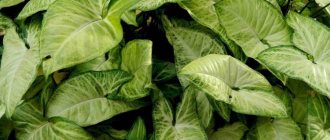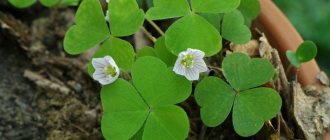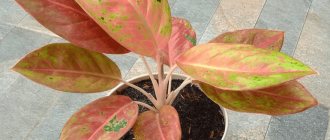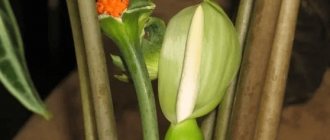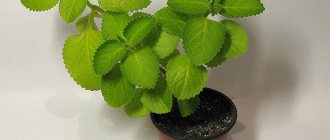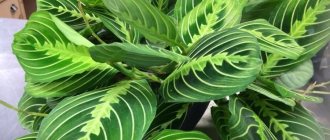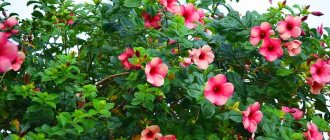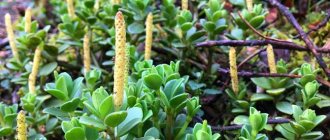Gasteria Armstrong variegata Gasteria is a genus of succulents in the Asphodelaceae , 75 species. It got its name because of the characteristic shape of the flower, reminiscent of a stomach . Together with Aloe and Haworthia, with which it has many similarities, Gasteria is included in the tribe Aloeceae . They grow in the arid regions of South Africa. Gasteria are found on rocky slopes, where, due to their ability to reproduce vegetatively, they form small curtains. Gasterias are perennial leafy herbaceous succulents with thick, fleshy, strap-shaped or tongue-shaped leaves collected in dense rosettes . In young Gasteria, the leaves are arranged in two rows ; with age, the arrangement changes to a spiral one . In some species (for example, G. warty), the two-row arrangement of leaves remains throughout life. The edges of the leaves are usually smooth, the tip is sharp. The surface of the leaves is usually uneven, with characteristic tubercles that form a pattern specific to each species. The flowers are small, tubular, with a characteristic swelling at the base. The difference between Gasteria flowers and Haworthia flowers: in Gasteria the structure of the flowers is tubular, i.e. all the petals are fused, while in Haworthia the petals are only half fused, and their bent petal-like segments are clearly distinguishable at the top. Gasteria flowers are usually red, yellow or orange, located on a long peduncle in an apical one-sided raceme. Like aloe, Gasteria flowers have nectaries that attract insects, although they are self-pollinating. The fruit is a capsule with dust-like seeds, which are spread by the wind, shaking the tall peduncle. But seeds rarely set.
The difficulties of classification are due to the fact that even under natural conditions different types of gasteria easily hybridize with each other. For indoor gasteria obtained by hybridization, the name Gasteria sp. is usually used.
Gasteria warty
The most famous types of gasteria with photos, descriptions, conditions of detention and methods of reproduction
Armstrong's Gasteria (Gasteria armstrongii)
Perennial herbaceous stemless plant. It looks very unique and will attract attention with its very laconic appearance. This is a plant with a small number of very dark, wide, short leaves that are almost spread out on the ground. The leaves of Gasteria Armstrong are tongue-shaped, very thick, 2-4 cm long, 3 cm wide, dark green, wrinkled, with tubercles, arranged in two rows, and in old age - in a spiral in the form of a rosette. The flowers are about 2 cm long, salmon pink. Homeland - South Africa. Rare species in cultivation. It grows very slowly and is the pride of every collector.
Tiny Gasteria bicolor (Gasteria bicolor v. liliputana)
Diseases and pests of Gasteria
Many people believe that the tough foliage of succulents is virtually invulnerable to diseases and pests. This idea is not without meaning, but gasteria can still be attacked by pathogens and insects. The most dangerous of them are:
- Gray and root rot. They arise as a result of excessive watering and waterlogging of the soil in the pot. Even replanting the plant is powerless in this case. You can save the plant by leaf propagation. Moreover, this must be done while there are undamaged cuttings left in the outlet.
- Aphid. Colonies of these sucking parasites inhibit the development of the flower. As a result of their vital activity, the death of culture is inevitable. Insecticidal preparations (“Aktara”, “Aktellik”) are the salvation from the scourge. As an alternative, you can use traditional methods (onion-garlic broth, tobacco infusion).
- Spider mites. Their presence is manifested by dry yellow dots on the leaf blades and a barely noticeable silvery sticky coating. Insecticidal preparations “Avers”, “Exirel”, “Caesar”, “Tsvetolux” will help get rid of pests.
Even a novice gardener can grow gasteria at home. If you follow all agrotechnical rules for caring for the plant, you will be able to admire its pretty bells every year.
Gasteria maculata
Perennial herbaceous plant. Gasteria spotted is one of the large species, reaching a height of 30 cm and above with age, characterized by smooth, dense dark green leaves. The rosettes are two-row, the leaves are succulent, hard, green with light speckles, 5-10 cm in length. The leaves are numerous, biserial, linear or short strap-shaped, up to 20 cm long and 4-5 cm wide, unevenly 3-sided, with a cartilaginous apical spine, dark green, with a large white spot. The flowers are bright red.
Gasteria spotted variegata
Gasteria maculata f. variegata First double-rowed, later curling rosette. The leaves are 5-15 cm long, succulent, hard, bluish-gray with alternating light and dark longitudinal stripes.
Gasteria beautiful
Care and maintenance at home
At home, gasteria does not have great care requirements. However, some conditions still need to be met. This indoor plant loves fresh air, but when ventilating the room, it is better to remove the flower from the windowsill. Place your gasteria in the bedroom, because at night it absorbs carbon dioxide, and during the day it releases oxygen.
The soil
For growing gasteria, soil can be purchased in specialized stores. The soil is also suitable for cacti. Or prepare the substrate yourself. To do this, take:
- leaf soil - 2 parts;
- turf – 2 parts;
- sand - 1 part, and also, for good passage of water and air, you can loosen the soil with brick chips or coarse sand.
Bloom
The flowering period of gasteria falls in spring and summer. Flowering lasts up to 30 days. A long, up to 70 centimeters, dark orange peduncle emerges from the rosette. It bears buds that look like bells. As usual - two colors, and smoothly transitioning into each other. In place of faded buds, seed boxes appear. You should not move the flower pot at this time, and try to maintain the same air temperature.
The autumn-winter period is a season of rest. The exception is Gasteria maculata; it “goes into hibernation” in the summer.
During this period, watering of the plant is reduced, feeding is stopped and the air temperature is slightly reduced (12-15 degrees). A faded peduncle should not be cut off; it is better to wait until it dries, then it will be easier to separate it.
Temperature
The comfortable temperature for gasteria during the flowering period should be +18..+25 degrees; in winter it requires cooling to +6...+12 degrees. By exceeding the temperature norm in the autumn-winter period, you can deprive yourself of the joy of admiring the blooms in spring. If possible, it is best to move the gasteria to a cool place, but to a bright window.
The lowest temperature a plant can tolerate is 5 degrees.
Lighting
In deserts, gasteria grows among bushes, in their shade. Try to create the same conditions for her at home. If you have cacti, place them nearby. Direct sunlight can affect leaf patterns. It is better to choose windows for placing plants with access to the southeast and southwest. A cold windowsill can destroy a flower, as can drafts.
In bright light, the leaves change color - they turn red.
But they easily return to their previous appearance in partial shade. Artificial lighting can be a good solution - use lamps for this up to 16 hours a day.
Air humidity
Gasteria does not need high humidity and easily tolerates room air. Like other succulents, it does not tolerate large amounts of moisture. Sometimes you can take a small shower to wash off the dust from the leaves. After bathing, you should protect the plant from the sun, as the leaves can get burned.
Tiny Gasteria (Gasteria lilipuiana)
Other names and subspecies: Gasteria bicolor c. liliputana (tiny) (Gasteria bicolor v. liliputana). Gasteria tiny is a perennial miniature herbaceous stemless plant with numerous shoots extending from the base. The leaves are lanceolate, from 3.5 to 6 cm long, dark green, shiny, with white spots. The leaf arrangement in young plants is two-row, in adults - in a spiral in the form of a basal rosette. The flowers are elegant, about 1.5 cm long, pink at the bottom, green at the top. Homeland - South Africa (Cape Province).
Gasteria glomerata
Gasteria variety Little Varty, or small wart
Reproduction
There are several known options through which you can propagate gasteria. Among the most popular are the following:
- Seeds. Sand collected in a container with low walls is used as soil. To do this, seed material is sown on the surface of wet sand (you can moisten it with a spray bottle). After this, the seeds are not covered. The container is covered with transparent plastic film or glass. The air temperature in the room should be between 15-18°. As the top layer of sand dries, it should be moistened with a spray bottle. After the first shoots appear, the cover is removed. As the seedlings grow, they are transplanted into a new pot after 30-40 days.
- Children. This propagation option, according to experienced gardeners, is considered the most effective and affordable. Its use makes it possible to preserve the maternal properties of the species, which cannot be guaranteed during seed propagation. When transplanting, the babies are carefully separated from the mother plant (using a sharp knife or blade, which are pre-treated with a disinfectant solution). The children are planted in new containers of the appropriate size. Caring for a transplanted baby is no different from caring for an adult flower. In 2-3 weeks the baby will take root.
- Leaves. To propagate gasteria by leaves, it is recommended to use a healthy leaf blade, which is carefully separated from the mother plant. After cutting, the leaf petiole should dry for 2-3 days in a room protected from sunlight. To root it, use a container filled with wet sand. The container is covered with film and not watered for 2-3 weeks. After this time, the leaf cutting will produce young roots. After this, it can be transplanted to a permanent place of growth.
Reproduction by seeds or separation of children
Gasteria can be propagated in two ways. Both have some features that are worth considering.
Seeds
Growing from seeds takes some time. It is necessary to prepare suitable and loose soil. The soil is moistened and seeds are sprinkled on top. Cover the container with glass or film and leave in a warm place. The soil is periodically moistened.
After a couple of months, the first shoots will appear. When the plant already has 4 leaves, it can be transplanted into a separate pot in a permanent place.
Children's department
This method is much simpler and faster. An adult plant often produces small children nearby. They are separated and dug up. Together with the soil, the sprouts are placed in new pots and watered well. After some time, the plant will begin to develop and grow.
Gasteria can be propagated using leaves. Separate one from an adult flower, sprinkle the cut with crushed coal and dry it a little. After a couple of days, place it in moist soil. After about a month, the first roots will appear and the sprout can be transplanted to a permanent place. The succulent grows for a very long time.
Important! The choice of reproduction method depends on the preferences and capabilities of the person. Gasteria has many types
Gasteria has many types
Care
Lighting
Gasteria prefers well-lit window sills, especially variegated species, the color of which is more pronounced in the sun. However, the plant cannot be placed in direct sunlight, otherwise the leaves will first turn red and then get burned. On southern windows in summer the plant should be shaded.
On northern windows, gasteria will grow, but will not bloom. East and west windows are best suited for this plant. In summer, gasteria can be taken out into the open air without direct sunlight. In winter, the plant responds well to additional lighting. The plant needs to be illuminated for approximately 16 hours at a distance of 40-50 cm from the plant.
To create additional illumination, fluorescent and LED lamps are chosen. But it is best to purchase special phytolamps. All lamps have different color temperatures, which are measured in Kelvin (K). It is the color temperature that is important for the plant. Depending on the needs, the required lamp power is selected:
- 2700K – consists of a predominantly red spectrum, which stimulates the plant to bloom;
- 4200K - consists of a yellow and green spectrum, but does not have any benefit for plants, however, such light is pleasant to the human eye;
- 6400K – in such lamps the blue spectrum dominates, which stimulates the growth of green mass of the plant.
Watering and humidity
Since gasteria is a desert plant, moderate watering is required as the soil dries out. The main thing is not to flood the flower, as it can quickly rot. In winter, watering should be reduced to 2 times a month. It is best to water not from above, as usual, but by immersing the pot in a container of water. The pot is immersed in water by about 2-4 cm and left there for 40-60 minutes.
There is no need to spray the leaves. During the heating season, it is good to place containers of water around the pots or turn on a humidifier. You can also place a pot with a plant on pebbles in the water.
Temperature
Gasteria tolerates heat well, but still feels better at a temperature of about +25°C. In winter, it is better to reduce the temperature to +10-15°C. This temperature difference is necessary for the formation of flower buds. Otherwise, gasteria will not bloom in summer. When ventilating, remove the plant from the windowsill.
Also read: Top 15 rare species of succulents with photos and names. Choose a plant to your liking!
Fertilizers
In the summer, gasteria must be fed with inorganic fertilizers for succulents in half the dosage. When choosing a fertilizer, you should look at the amount of nitrogen in it, since its excess leads to rotting of the roots. The ideal formula for gasteria looks like 9-24-18 (nitrogen-phosphorus-potassium). It is better to fertilize no more than twice a month.
Transplantation and soil selection
Transplantation into new soil is carried out every two years due to the fact that the plant grows and develops slowly. The pot for gasteria should not be large. It should be tight. Gasteria loves small pots due to the fact that its roots are not able to develop a large lump of earth.
The soil must be specialized - for succulens or cacti. If it is not possible to buy such a substrate, then make it yourself so that it is rich in humus and contains sand. To do this, take a mixture of leaf and turf soil, sand, peat and charcoal (2: 2: 2: 1: 1). At the bottom of the pot you need to pour brick chips, small pebbles or vermiculite (perlite). The mixture should be light - moisture- and breathable.
Bloom
Gasteria blooms in spring and summer. But if the plant is on a northern or very shaded windowsill, then it may not bloom. The flowers are drooping, in the shape of a curved bell, about 2 cm in size. The color is most often pink or orange. They are located on a high peduncle in large numbers - about 50-60 flowers.
Pests and diseases
Gasteria are not prone to diseases, the main cause of which can only be careless care and improper watering of plants.
Flooding of the root system leads to rotting and soon death of seedlings. When there is an excess of moisture, fungal infections of gasteria begin to form.
On the contrary, forgetting the rules for watering gasteria and creating a drought during the flowering period, the leaves become pale, the whole plant becomes covered with dry brown spots. Soft brown spots are a sign of bacterial infection.
Yellowness on the leaves indicates burns from excessive ultraviolet radiation. Also, with hyperinsolation, the dark green color of the stem and leaves can change to brown-red.
Gasteria is rarely subject to an influx of harmful insects due to its dense, fleshy stem and thick leaf cover, but sometimes scale insects, aphids or mealybugs can be found.
Problems arise when growing recommendations are violated. With proper care and appropriate light conditions, there are no problems in growing gasteria. Proper care and timely watering of gasteria ensures the growth and development of the plant for many years.
| Growing | Grows well at moderate temperatures: in the warm season about +18-24°C, in winter - +6-+15°C. The plant is light-loving and does not develop well when kept in the shade. |
| Humidity | The spring-autumn period requires abundant watering - once a week. In the autumn-winter period, the moisture capacity is reduced, watering is reduced to a minimum - once every 1-2 months, no need to spray. |
| Feeding and pruning | Feed once every 1-2 months with a weak solution of fertilizer for cacti or any complex product for indoor plants. No pruning needed. |
| Flowering period | Comes in spring or summer. Lasts 2-4 months, until the first cold weather. Does not bloom on the north side. |
| Landing, transplant | Grows on turf and leaf soil with the addition of sand and loosening material. Transplantation is carried out once every 2-3 years, as it grows out of the old pot. The transplantation procedure is carried out by transferring the flower from one pot to another without destroying the earthen clod. |
| Reproduction | Seeds, leaf cuttings, babies. |
| Pests | Mealybugs, spider mites, scale insects, aphids. |
| Diseases | None. |


